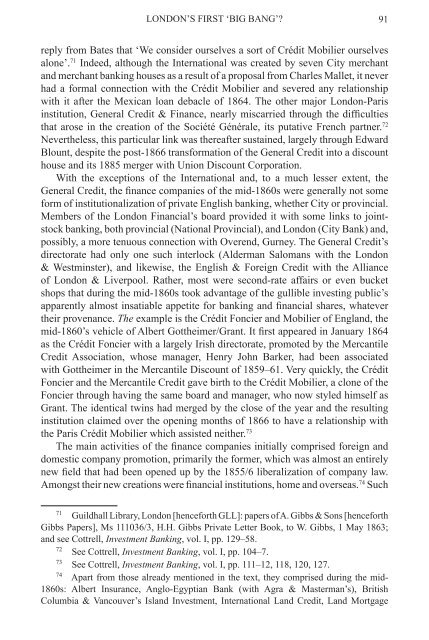the world of private banking
the world of private banking
the world of private banking
You also want an ePaper? Increase the reach of your titles
YUMPU automatically turns print PDFs into web optimized ePapers that Google loves.
LONDON’S FIRSt ‘BIG BANG’? 91<br />
reply from Bates that ‘We consider ourselves a sort <strong>of</strong> Crédit Mobilier ourselves<br />
alone’. 71 Indeed, although <strong>the</strong> International was created by seven City merchant<br />
and merchant <strong>banking</strong> houses as a result <strong>of</strong> a proposal from Charles Mallet, it never<br />
had a formal connection with <strong>the</strong> Crédit Mobilier and severed any relationship<br />
with it after <strong>the</strong> Mexican loan debacle <strong>of</strong> 1864. The o<strong>the</strong>r major London-Paris<br />
institution, General Credit & Finance, nearly miscarried through <strong>the</strong> difficulties<br />
that arose in <strong>the</strong> creation <strong>of</strong> <strong>the</strong> Société Générale, its putative French partner. 72<br />
Never<strong>the</strong>less, this particular link was <strong>the</strong>reafter sustained, largely through Edward<br />
Blount, despite <strong>the</strong> post-1866 transformation <strong>of</strong> <strong>the</strong> General Credit into a discount<br />
house and its 1885 merger with Union Discount Corporation.<br />
With <strong>the</strong> exceptions <strong>of</strong> <strong>the</strong> International and, to a much lesser extent, <strong>the</strong><br />
General Credit, <strong>the</strong> finance companies <strong>of</strong> <strong>the</strong> mid-1860s were generally not some<br />
form <strong>of</strong> institutionalization <strong>of</strong> <strong>private</strong> English <strong>banking</strong>, whe<strong>the</strong>r City or provincial.<br />
Members <strong>of</strong> <strong>the</strong> London Financial’s board provided it with some links to jointstock<br />
<strong>banking</strong>, both provincial (National Provincial), and London (City Bank) and,<br />
possibly, a more tenuous connection with Overend, Gurney. The General Credit’s<br />
directorate had only one such interlock (Alderman Salomans with <strong>the</strong> London<br />
& Westminster), and likewise, <strong>the</strong> English & Foreign Credit with <strong>the</strong> Alliance<br />
<strong>of</strong> London & Liverpool. Ra<strong>the</strong>r, most were second-rate affairs or even bucket<br />
shops that during <strong>the</strong> mid-1860s took advantage <strong>of</strong> <strong>the</strong> gullible investing public’s<br />
apparently almost insatiable appetite for <strong>banking</strong> and financial shares, whatever<br />
<strong>the</strong>ir provenance. The example is <strong>the</strong> Crédit Foncier and Mobilier <strong>of</strong> England, <strong>the</strong><br />
mid-1860’s vehicle <strong>of</strong> Albert Got<strong>the</strong>imer/Grant. It first appeared in January 1864<br />
as <strong>the</strong> Crédit Foncier with a largely Irish directorate, promoted by <strong>the</strong> Mercantile<br />
Credit Association, whose manager, Henry John Barker, had been associated<br />
with Got<strong>the</strong>imer in <strong>the</strong> Mercantile Discount <strong>of</strong> 1859–61. Very quickly, <strong>the</strong> Crédit<br />
Foncier and <strong>the</strong> Mercantile Credit gave birth to <strong>the</strong> Crédit Mobilier, a clone <strong>of</strong> <strong>the</strong><br />
Foncier through having <strong>the</strong> same board and manager, who now styled himself as<br />
Grant. The identical twins had merged by <strong>the</strong> close <strong>of</strong> <strong>the</strong> year and <strong>the</strong> resulting<br />
institution claimed over <strong>the</strong> opening months <strong>of</strong> 1866 to have a relationship with<br />
<strong>the</strong> Paris Crédit Mobilier which assisted nei<strong>the</strong>r. 73<br />
The main activities <strong>of</strong> <strong>the</strong> finance companies initially comprised foreign and<br />
domestic company promotion, primarily <strong>the</strong> former, which was almost an entirely<br />
new field that had been opened up by <strong>the</strong> 1855/6 liberalization <strong>of</strong> company law.<br />
Amongst <strong>the</strong>ir new creations were financial institutions, home and overseas. 74 Such<br />
71<br />
Guildhall Library, London [henceforth GLL]: papers <strong>of</strong> A. Gibbs & Sons [henceforth<br />
Gibbs Papers], Ms 111036/3, H.H. Gibbs Private Letter Book, to W. Gibbs, 1 May 1863;<br />
and see Cottrell, Investment Banking, vol. I, pp. 129–58.<br />
72<br />
See Cottrell, Investment Banking, vol. I, pp. 104–7.<br />
73<br />
See Cottrell, Investment Banking, vol. I, pp. 111–12, 118, 120, 127.<br />
74<br />
Apart from those already mentioned in <strong>the</strong> text, <strong>the</strong>y comprised during <strong>the</strong> mid-<br />
1860s: Albert Insurance, Anglo-Egyptian Bank (with Agra & Masterman’s), British<br />
Columbia & Vancouver’s Island Investment, International Land Credit, Land Mortgage












![[Pham_Sherisse]_Frommer's_Southeast_Asia(Book4You)](https://img.yumpu.com/38206466/1/166x260/pham-sherisse-frommers-southeast-asiabook4you.jpg?quality=85)



